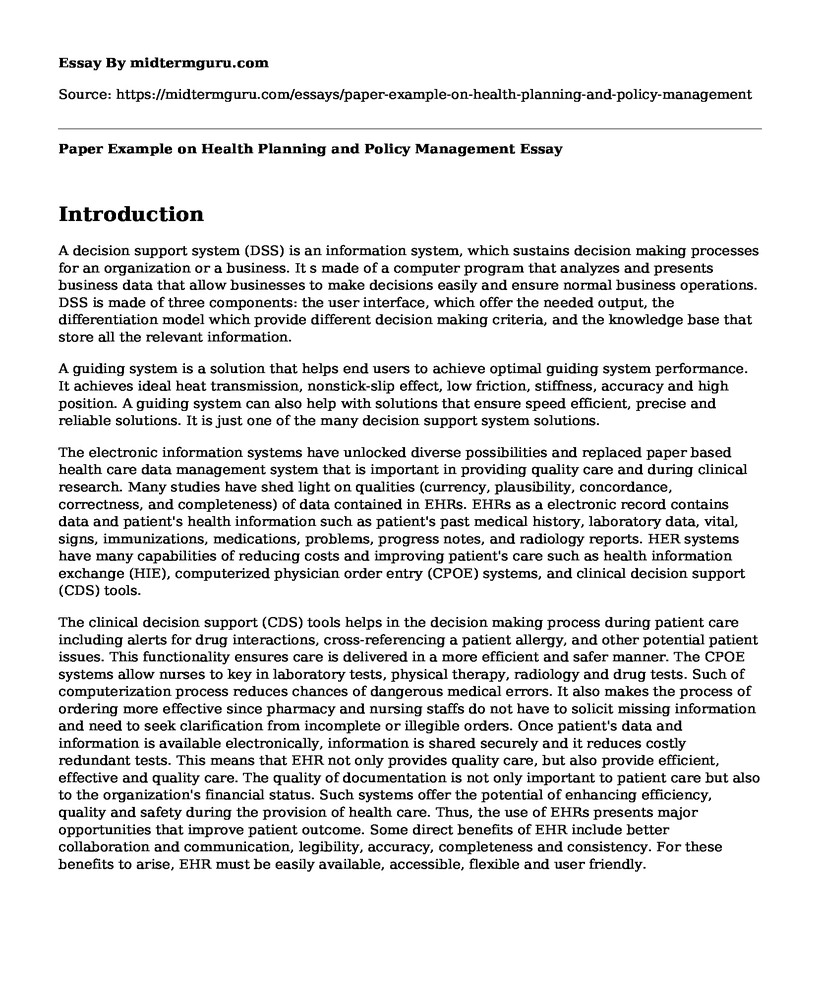Introduction
A decision support system (DSS) is an information system, which sustains decision making processes for an organization or a business. It s made of a computer program that analyzes and presents business data that allow businesses to make decisions easily and ensure normal business operations. DSS is made of three components: the user interface, which offer the needed output, the differentiation model which provide different decision making criteria, and the knowledge base that store all the relevant information.
A guiding system is a solution that helps end users to achieve optimal guiding system performance. It achieves ideal heat transmission, nonstick-slip effect, low friction, stiffness, accuracy and high position. A guiding system can also help with solutions that ensure speed efficient, precise and reliable solutions. It is just one of the many decision support system solutions.
The electronic information systems have unlocked diverse possibilities and replaced paper based health care data management system that is important in providing quality care and during clinical research. Many studies have shed light on qualities (currency, plausibility, concordance, correctness, and completeness) of data contained in EHRs. EHRs as a electronic record contains data and patient's health information such as patient's past medical history, laboratory data, vital, signs, immunizations, medications, problems, progress notes, and radiology reports. HER systems have many capabilities of reducing costs and improving patient's care such as health information exchange (HIE), computerized physician order entry (CPOE) systems, and clinical decision support (CDS) tools.
The clinical decision support (CDS) tools helps in the decision making process during patient care including alerts for drug interactions, cross-referencing a patient allergy, and other potential patient issues. This functionality ensures care is delivered in a more efficient and safer manner. The CPOE systems allow nurses to key in laboratory tests, physical therapy, radiology and drug tests. Such of computerization process reduces chances of dangerous medical errors. It also makes the process of ordering more effective since pharmacy and nursing staffs do not have to solicit missing information and need to seek clarification from incomplete or illegible orders. Once patient's data and information is available electronically, information is shared securely and it reduces costly redundant tests. This means that EHR not only provides quality care, but also provide efficient, effective and quality care. The quality of documentation is not only important to patient care but also to the organization's financial status. Such systems offer the potential of enhancing efficiency, quality and safety during the provision of health care. Thus, the use of EHRs presents major opportunities that improve patient outcome. Some direct benefits of EHR include better collaboration and communication, legibility, accuracy, completeness and consistency. For these benefits to arise, EHR must be easily available, accessible, flexible and user friendly.
Conclusion
Most clinical outcomes that have been linked to EHR are lined to patient safety and quality of care. Quality care results from doing the right thing the right way at the right time, which leads to patient safety and best results. Therefore, EHR focuses on efficiency, effectiveness and safety of patients. HER with CDC tools are believed to increase patient's adherence to effective care and evidence based clinical guidelines. HER try to overcome issues such as nurses not knowing the guidelines, lack of time during the patient visit, and nurses not realizing the kind of guideline that is applicable to a particular patient. Instead EHRs focus on preventive services such as how to improve the rate of adherence among patients.
References
Linder, J. A., Ma, J., Bates, D. W., Middleton, B., & Stafford, R. S. (2007). Electronic health record use and the quality of ambulatory care in the United States. Archives of internal medicine, 167(13), 1400-1405.
Pizziferri, L., Kittler, A. F., Volk, L. A., Honour, M. M., Gupta, S., Wang, S., ... & Bates, D. W.
(2005). Primary care physician time utilization before and after implementation of an electronic health record: a time-motion study. Journal of biomedical informatics, 38(3), 176-188.
Weiskopf, N. G., & Weng, C. (2013). Methods and dimensions of electronic health record data quality assessment: enabling reuse for clinical research. Journal of the American Medical Informatics Association, 20(1), 144-151.
Cite this page
Paper Example on Health Planning and Policy Management. (2022, Sep 06). Retrieved from https://midtermguru.com/essays/paper-example-on-health-planning-and-policy-management
If you are the original author of this essay and no longer wish to have it published on the midtermguru.com website, please click below to request its removal:
- Paper Example on ER Nurses Organization
- Key Elements of a Strong or Positive Organization Culture and Diversity Management - Papaer Example
- Essay on Success of the Planning-Programming-Budgeting System at the Department of Defence
- Paper Example on Injuries That Occur in a Dentist Office
- Paper Example on Physician-Assisted Suicide and Hospital Policy
- Research Paper on Insulin Suppression Feedback and p13K Inhibitors
- Good Bacteria: The Role of Probiotics in Cultures Worldwide - Research Paper







